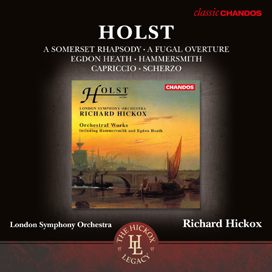Holst Orchestral Works
September 22, 2016

CLASSIC CHANDOS SERIES
chandos 10911x
There are many of us who believe that Gustav Holst (1874-1934) was only known for The Planets and nothing else. He was a one and done composer like Dukas and Sorcerers Apprentice, Borodin and his Prince Igor along with many other composers. This is not true and this re-release will show you some of the wonderful music that he has to offer.In this recording Holst wrote about the barren land of Egdon Heath, the business of Hammersmith, a movement of an unfinished symphony, and an overture to an opera.
“Fugal Overture,” written in 1922 was an overture of the opera The Perfect Fool, performed in 1923. Written in a neoclassicism style Holst originally titled this a Fugal Ballet. Holst makes effective use of the glockenspiel giving it a sparkle which changes into an overpowering brass motif. “A Somerset Rhapsody” was written in 1907 and is a trio of folksongs that are eventually combined and performed using different color orchestrations. The three folksongs are “It’s A Rosebud in June” features the oboe which is tranquil and peaceful and transmits love and peace. The middle selection “High Germany” a rousing march filled with a robust brass fanfare which is filled with melody and counterpoint. The transition between the first and the second is flawless and you don’t realize it until you listen for it. The final tune is “The Lovers Farewell followed by the combing of the tunes.
“Scherzo” was the only completed movement of his unfinished Choral Symphony from 1925. After his death it was released and performed in 1935 with Adrian Boult conducting. The liner note writer Lewis Foreman (excellent notes) gave it the title ‘great might-have-beens.’ If your looking for something loud and uplifting this is the track for you. “Egdon Heath” based on the writings of Thomas Hardy in his novel Return of the Native which Hardy was aware of what Holst was doing. Holst used the Hardy words to inspire his writing. “A place perfectly accordant with mans nature-neither ghastly, hateful, nor ugly: neither commonplace, unmeaning, nor tame: but, like man, slighted and enduring: and withal singularly colossal and mysterious in its swarthy monotony.” The theme in a minor key is offered by the brass section which leads us into a section of dissonance and despair. The string section continues the theme primarily in the wind section with harmony from the brass (a forte of Holst). Overall this 16+ minute work is one that will sway your emotions. Well done by Hickox and the London Symphony Orchestra. “Hammersmith” is written for band originally but Holst re-orchestrated it for symphony orchestra and it was conducted by Boult in 1931. The piece is based on the bustle of the city Hammersmith along with the slow flowing motion of the river. A rather dissonant piece with a nice melody I’ve not heard it for concert band but would certainly like to do so The final selection is a piece that Holst was commissioned to write when he was lecturing at Harvard for concert band for a radio concert which never came off. Holst called it his jazz band piece which it was really not. His daughter arranged the lively piece which has now become a standard in his recorded offerings.
Hickox is a master interpreter of Holst and there are other offerings in the vast choices from Naxos and Chandos. He isn’t just about Planets and these 6 offerings are an outstanding example of what he has to offer.
Look forward to 4 new releases in 2017 in the Hickox series including the Double Concerto from Holst, Light of Life from Elgar, The Black Knight from Elgar, and The Bear from Walton. Chandos is truly a major player in the classical world.